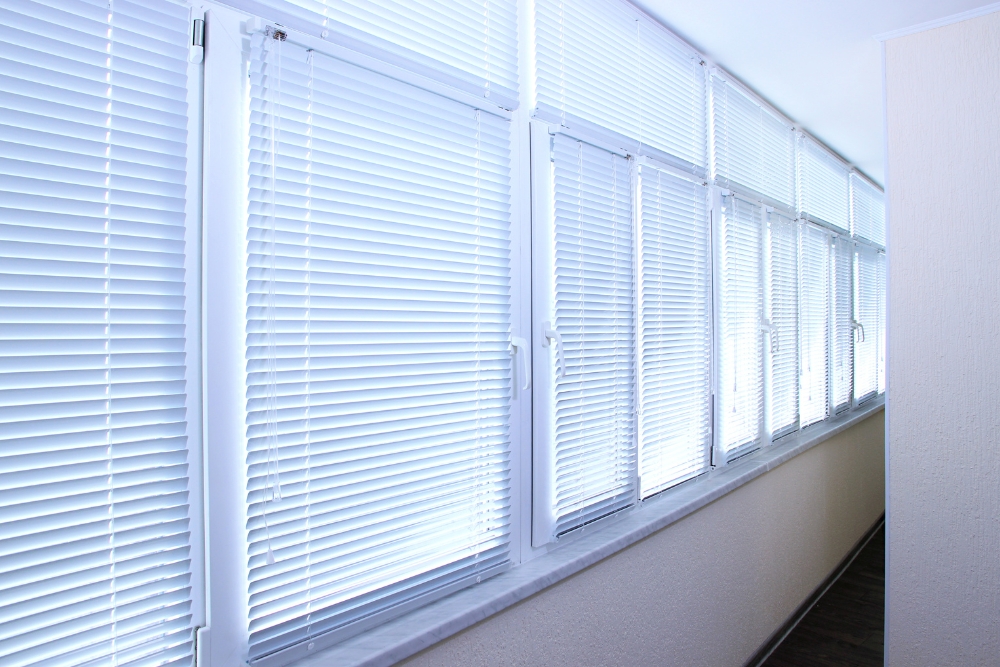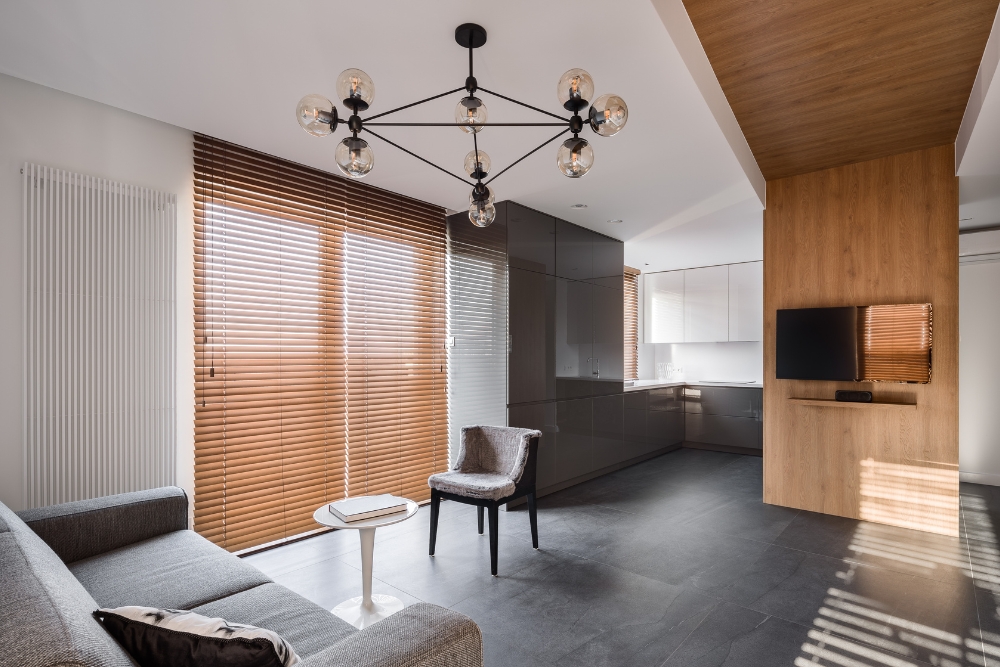Picking the perfect shades for our window dressings can be a real head-scratcher, can’t it? We’ve all found ourselves squinting at colour swatches, attempting to picture how they’ll transform our cosy nooks. But it’s not just about what looks good, you know? There’s a stack of research out there showing that colours don’t just jazz up a space – they seriously affect how we feel and act.
That’s why picking the right ones is more than crucial; it sets the whole vibe of your home. Our yarn today will weave through the intriguing tapestry of colour psychology to lend you a hand in choosing shutters and blinds that aren’t just easy on the eyes but also give your mood a little lift. So let’s bring some colour wizardry into your abode and have those windows looking ace!
Key Takeaways
- Understanding colour psychology helps create the right mood in each room of your home. For example, blues and greens are calming—perfect for bedrooms, while reds can bring warmth to lively areas like living rooms.
- Choose window coverings that match both your style and the purpose of the room. This means considering how different colours make you feel and what kind of atmosphere you want to foster.
- Test out colour samples in your actual space before making a decision. Colours can change with lighting throughout the day, so it’s important to see how they look at different times in natural and artificial light.
- Think about how blind or shutter colours will stand up over time—not just with changing decor trends but also regarding cleaning and maintenance.
- Your taste is key when selecting colours. Go for hues that speak to you personally and ensure they align with how you want your home to look and feel long-term.
The Impact of Colour Psychology in Shutter and Blind Selection
Understanding the psychology of colours is crucial in selecting the right shutters and blinds for your home. The significance of colour in interior design cannot be underestimated as it plays a key role in creating the desired ambiance.
Understanding the psychology of colours
Every shade tells a story, and in the world of interior design, colours aren’t just for show—they shape how we feel inside a room. We dive into colour psychology to unlock secrets that can transform any space.
Bright yellows lift spirits and energise, perfect for kitchens or play areas where you want to spark creativity and joy. Soothing blues create a tranquil oasis ideal for bedrooms or bathrooms where relaxation is key.

Selecting your shutters or blinds goes beyond matching them with wall paint. It’s about crafting an environment that resonates with your emotions and enhances your well-being. Imagine red hues adding warmth and excitement to social spaces like living rooms – it’s like igniting conversations without saying a word! Our homes reflect our style while shaping our mood; this understanding guides us to choose window coverings that are more than just decor but also tools for emotional harmony within our sanctuaries.
The significance of colour in interior design
Colour plays a crucial role in interior design, influencing the mood and ambience of your living space. By understanding the psychology of colours, we can enhance the atmosphere within our homes.
For instance, warm colours like red and orange can create a cosy and inviting feel, while cool tones such as blue and green evoke a sense of calmness. It’s important to consider how different shades will impact your room before selecting window coverings; for example, vibrant hues might energise a social area but be too stimulating for a bedroom.
To achieve the desired effect, homeowners should carefully assess their preferences and intentions when choosing colour schemes. Additionally, it’s essential to acknowledge how certain combinations complement or contrast each other within the overall decor scheme.
Creating the desired ambience
Selecting the right colours for your window coverings can greatly influence the ambience of a room. Whether you want to create a calm and tranquil atmosphere in your bedroom or a vibrant and energising feel in your living room, choosing the appropriate colours for your blinds or curtains is essential.
Warm tones such as reds, oranges, and yellows can add cosiness and intimacy to a space, while cool shades like blues and greens can promote feelings of relaxation and serenity. By understanding how different colours impact mood and emotions, you can effectively set the desired ambience in each room of your home.
When selecting colours for your window coverings, consider the overall theme or style you want to achieve. For instance, if you aim to create a modern and minimalist look, opting for neutral hues like whites, greys, or muted tones can help achieve this aesthetic.
The Role of Colour in Window Coverings
Various colours have different psychological effects on individuals, so it’s important to carefully consider the impact of each colour when selecting window coverings. Understanding the psychology behind colours can help in creating the desired ambience and mood within a space.
Various colours and their psychological effects
Different colours can have unique psychological impacts on a room’s atmosphere. Understanding these effects can help you create the ambience you desire in your living spaces. Here are some common colours and their associated psychological effects:
- Blue: Known for its calming effect, blue can evoke feelings of serenity and relaxation. It’s an excellent choice for bedrooms and areas where you want to promote a sense of peace and tranquillity.
- Red: This bold colour can stimulate energy and excitement. It’s ideal for spaces where you want to create a sense of warmth and vibrancy, such as dining areas or social gathering spots.
- Green: Often associated with nature, green promotes feelings of harmony and balance. It’s a versatile colour that works well in various rooms, including living areas and home offices.
- Yellow: Bright and cheery, yellow can bring a sense of optimism and positivity to a room. It’s perfect for spaces where you want to encourage creativity and happiness, like kitchens or playrooms.
- Grey: A neutral hue that exudes sophistication and elegance, grey is an excellent choice for creating a modern, sleek look in your home.
- Purple: Symbolising luxury and creativity, purple can add a touch of glamour to any space. It’s great for accent pieces or statement window coverings.
Guidelines for selecting appropriate colours
Various colours and their psychological effects can have a profound impact on the ambience of a room. To ensure you select the most suitable colours for your window coverings, consider the following guidelines:
- Evaluate the room’s purpose: Consider the function of the space and the mood you want to create. For example, soothing blues or greens might be ideal for a bedroom, while energising reds or yellows could be more fitting for a kitchen or dining area.
- Balancing and contrasting colours: Choose colours that complement or contrast with existing elements in the room, such as furniture or wall paint. This will help create a cohesive and visually appealing look.
- Test samples: Before committing to a colour, obtain fabric samples and observe them in different lighting conditions throughout the day to see how they interact with natural light and artificial lighting.
- Think long-term: Select colours that have longevity in terms of style and appeal rather than following short-lived trends. This ensures that your window coverings remain relevant for years to come.
- Consider personal preferences: Ultimately, choose colours that resonate with you and contribute to the overall aesthetic of your home. Your taste is essential in creating a space that reflects your personality and style.
By carefully considering these guidelines, you can confidently select appropriate colours for your window coverings that align with your desired ambience and interior design vision.

Factors to Consider When Choosing Colour for Window Coverings
When choosing colours for window coverings, it’s crucial to think about the room’s purpose and how you want it to feel. Balancing and contrasting colours can create a visually appealing space, so be sure to consider that as well.
Testing sample colours in the actual space is essential, as they may appear different in natural light. And don’t forget about personal preferences – after all, you’re the one who will be living with your selection!
Evaluating the room’s purpose
Consider the function of each room when choosing colours for your window coverings. We assess how each space is used to decide on the most appropriate colour scheme that complements its purpose and the mood you want to create.
For instance, in a bedroom, calming and soothing colours may be preferable, while vibrant and energising shades might suit a home office or kitchen better. Our goal is to enhance the atmosphere of each room through thoughtful consideration of colour psychology.
Once we’ve identified the purpose of each room, we can select window treatments that not only complement but also enhance their intended use. By keeping this in mind during our selection process, we ensure that our blinds or shutters contribute positively to every area of our homes.
Balancing and contrasting colours
After evaluating the room’s purpose, it is crucial to consider balancing and contrasting colours when selecting window coverings. Achieving a harmonious balance between different shades can enhance the overall aesthetic appeal of your living space.
It’s important to choose colours that complement each other while also creating a sense of contrast to add visual interest. By carefully selecting and pairing different hues, you can create a dynamic and visually appealing atmosphere in your home.
When considering the psychology of colour in blind selection, bear in mind that certain combinations evoke specific emotional responses. Understanding how to balance and contrast colours effectively can help you achieve the desired ambience in each room while reflecting your style.
Testing samples
Once we have balanced and contrasted the colours for our window coverings, it’s essential to test samples before making a final decision. Testing samples allows us to see how the colour interacts with the natural light in the room and how it complements other design elements.
It helps us ensure that the selected colour creates the desired ambience and evokes the intended mood in our living spaces. Additionally, testing samples provide an opportunity to assess how different colours impact visual perception and aesthetics. When selecting blinds or shutters based on colour psychology, testing samples is crucial for understanding how various colours influence visual impairment and create a cohesive look within a space.
Thinking long-term
When selecting colours for window coverings, it’s essential to think ahead. Consider how the chosen colour will complement any future changes in your home decor or furniture. This will ensure that your window coverings remain cohesive and relevant over time.
Additionally, keeping long-term maintenance in mind is crucial. Opt for colours that are easy to maintain and won’t show wear and tear quickly. This allows you to enjoy your window coverings for years to come without worrying about frequent replacements.
Personal preferences
Consider your personal preferences when it comes to choosing the colour of your window coverings. Our tastes and styles play a significant role in creating a space that feels comfortable and reflects our personality.
Whether you prefer bold and vibrant colours to make a statement or neutral and calming tones for a soothing ambience, it’s important to select colours that resonate with you. Assessing your personal preferences will help you narrow down the wide range of colours available, ensuring that the window coverings you choose complement your overall decor scheme.
Once you’ve considered your personal preferences, think about how different colours can evoke specific moods and emotions within a room. Understanding this aspect of colour psychology will help align your choices with the desired ambience in each space throughout your home. By integrating these considerations into your decision-making process for selecting window coverings, you’ll be able to create an environment that not only looks visually appealing but also feels harmonious and comforting.
Master the Art of Colour for Your Blinds and Shutters
In conclusion, understanding the psychology of colour is essential when selecting shutters and blinds. Different colours can evoke specific emotions and set the desired ambience in a room.
By considering factors such as the room’s purpose, balancing and contrasting colours, testing samples, and thinking long-term, homeowners can make informed decisions about their window coverings. Ultimately, choosing the right colours for shutters and blinds can significantly impact the overall look and feel of a space.

